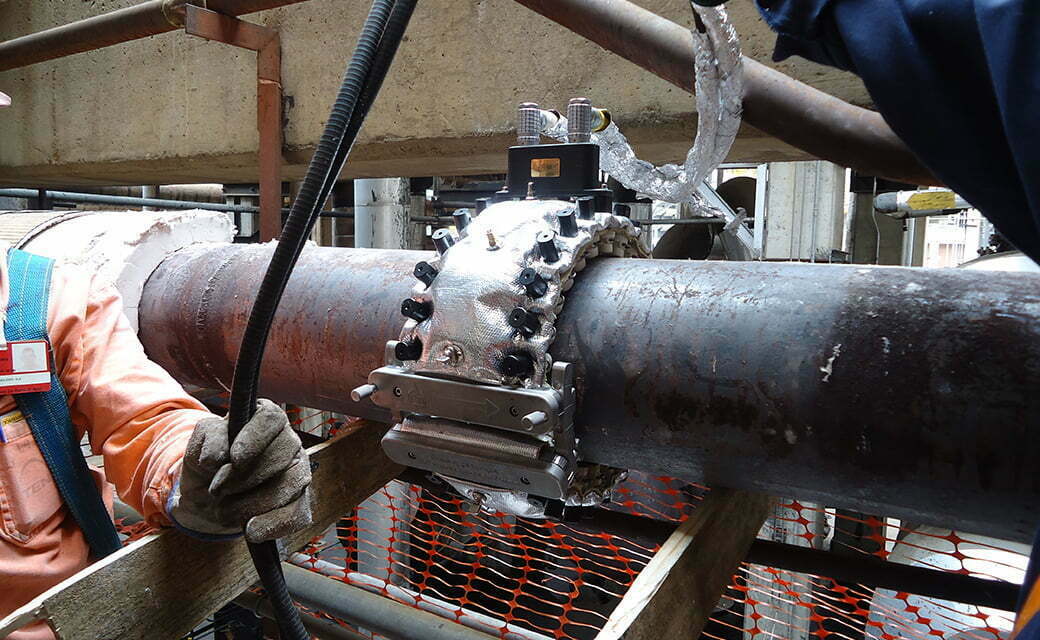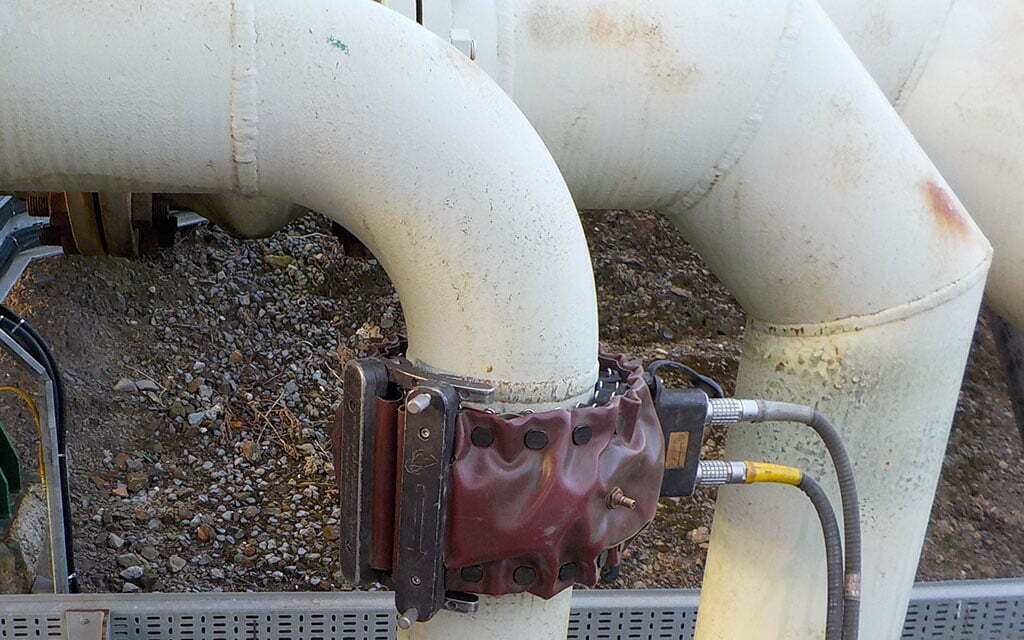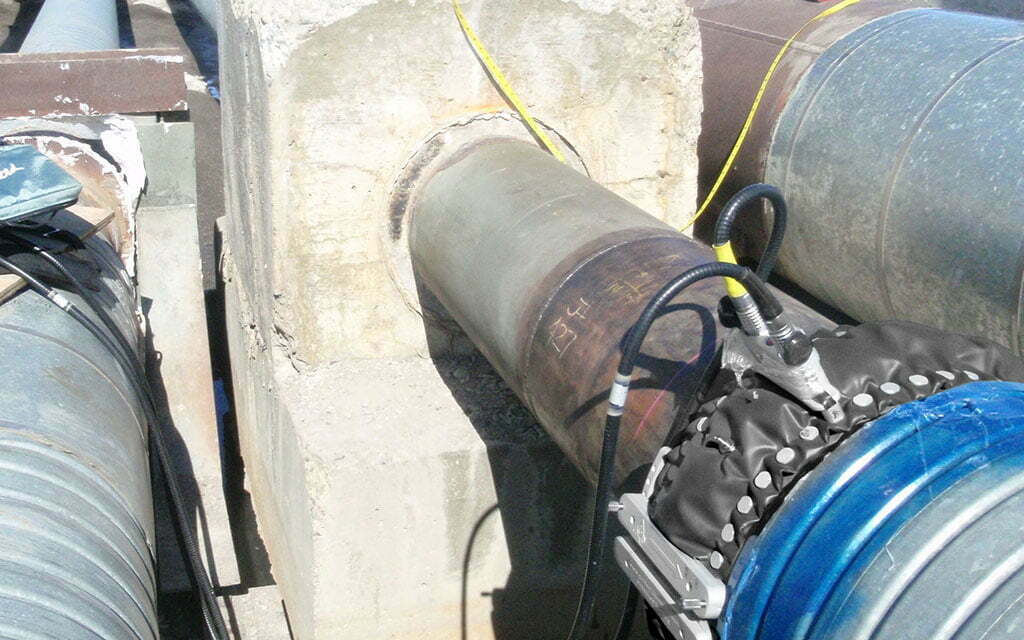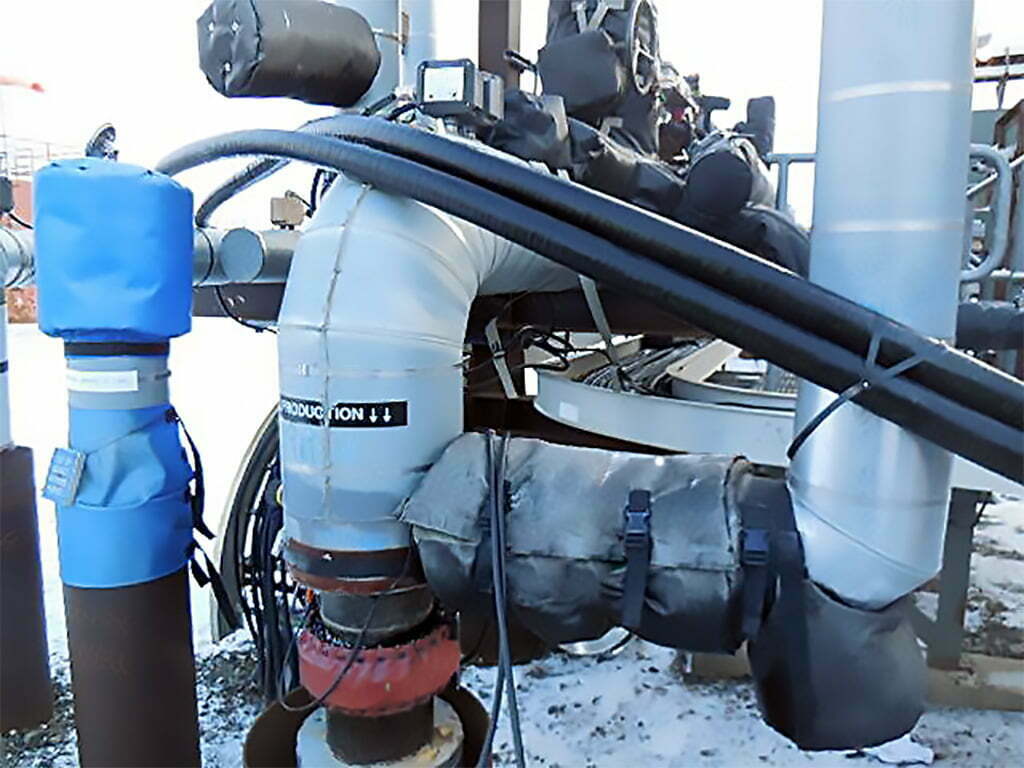Simple Support Corrosion Sizing
This case study demonstrates the application of the QSR1 for sizing of corrosion at a pipe section at a simple support location.
Studios
Guided Wave Testing (GWT) is now a standard Non-Destructive Testing (NDT) method to inspect pipework in many industrial disciplines, such as oil and gas, petrochemical and power generation sections. The torsional guided wave mode is highly sensitive to most defect types while experiencing low attenuation in most situations. In the majority of the applications, this mode is ideal for the inspections of a long length of pipework. Welds, supports, defects, and other features generate echoes from which their locations and severities (in the case of a defect) can be measured. The data is usually analysed on-site so that any follow-up or complementary inspections can be performed immediately.
An inspection is done by wrapping a removable transduction ring around the circumference of the tube/pipe at the desired location, which can be many metres away from the region of interest. Force is applied, either mechanically or pneumatically, to the transducers to obtain good coupling.


This case study demonstrates the application of the QSR1 for sizing of corrosion at a pipe section at a simple support location.

This case study demonstrates the capability of the Wavemaker® System to screen long lengths of pipework from a single location. In this case, 230m of pipe was screened from a single location.

This case study demonstrates the capabilities of the C-Scan, which is a synthetic focusing tool to determine the axial position and circumferential orientation of defects and pipe features.


Many sections of pipework within petrochemical plants are located high above the ground where they cross roadways or other pipe racks. Guided wave testing offers a unique solution to minimise access cost.

Earth walls are a common feature in petrochemical plants and tank farms where corrosion is often located at the soil/air interface. Guided Wave Testing can inspect both this interface and the buried section.

The Wavemaker® is an advanced NDT system capable of exciting guided waves to screen long lengths of pipework from a single location. In most straight pipe cases, tens of metres of pipes can be easily inspected with a 100% volumetric

Slug catchers are typically used in the oil and gas industries to collect slugs at the outlet of pipelines which transports gas & liquid together. In general, they are large in diameter (>48″) and highly susceptible to internal corrosion and

Corrosion under pipe supports (CUPS) is one of the leading causes of pipe failure. In most cases, supports have poor inspectability and maintainability because of the difficulty to access the area of interest.This case study describes a real inspection job

Corrosion under insulation (CUI) is a severe form of localized external corrosion which occurs in carbon and low alloy steel pipe that has been insulated. CUI is common in refineries and process plants that typically operate equipment at elevated temperatures

Pipes operating at temperatures as high as 350°C (660°F) can be inspected while in service using High Temperature (HT) rings with the Wavemaker® Pipe Screening System. This case studies shows an example result.

Bends or elbows are common pipe fittings which are susceptible to corrosion and erosion. Using the C-Scan, defects at elbows can be detected and prioritised.

Wall penetrations are a common feature within storage facilities and oil and chemical plants. They can be used to control the spillage of products or serve as pipe anchors. The HD series of rings simplifies their inspection by reducing the

With the advanced interpretation tools such as frequency sweeping and C-Scan, defective welds are usually detected as part of the guided wave inspection.

Deposits, such as sludge, can often be found in sporadic positions along pipelines. These deposits can result in accelerated localised corrosion promoted by different mechanisms, such as microbiologically-influenced corrosion (MIC). The pits created by such localized attack, as well as

The GUL Wavemaker® utilises guided wave modes that energise the entire volume of the pipe. Therefore it is an ideal non destructive testing method for the detection of random internal corrosion, especially when certain sections of the pipe are inaccessible.

Guided Wave Testing (GWT) offers a quick cost effective Non-Destructive Testing (NDT) solution for the inspection of lamp posts and street columns at regular intervals, improving repair and servicing priorities for decision making.

Elbows are common pipe fittings which are susceptible to corrosion and erosion. Using the Unrolled Pipe display, defects at elbows can be detected and prioritised.

Guided Wave Testing (GWT) using G-Scan® offers a solution for testing rail sections through a level crossing in a cost-effective way without lifting the roadway or disturbing the road or rail traffic movements.

Results of a feasibility trial show that Guided Wave Testing is an efficient and effective tool to monitor offshore platform caissons, enabling the classification of problem areas before they become failures.

Caisson Monitoring can be much improved by using guided wave permanently installed monitoring sensors or gPIMS®.

This case study demonstrates the application of the QSR1 for sizing of corrosion at a pipe section at a simple support location.

This case study demonstrates the capability of the Wavemaker® System to screen long lengths of pipework from a single location. In this case, 230m of pipe was screened from a single location.

This case study demonstrates the capabilities of the C-Scan, which is a synthetic focusing tool to determine the axial position and circumferential orientation of defects and pipe features.

Many sections of pipework within petrochemical plants are located high above the ground where they cross roadways or other pipe racks. Guided wave testing offers a unique solution to minimise access cost.

Earth walls are a common feature in petrochemical plants and tank farms where corrosion is often located at the soil/air interface. Guided Wave Testing can inspect both this interface and the buried section.

The Wavemaker® is an advanced NDT system capable of exciting guided waves to screen long lengths of pipework from a single location. In most straight pipe cases, tens of metres of pipes can be easily inspected with a 100% volumetric

Slug catchers are typically used in the oil and gas industries to collect slugs at the outlet of pipelines which transports gas & liquid together. In general, they are large in diameter (>48″) and highly susceptible to internal corrosion and

Corrosion under pipe supports (CUPS) is one of the leading causes of pipe failure. In most cases, supports have poor inspectability and maintainability because of the difficulty to access the area of interest.This case study describes a real inspection job

Corrosion under insulation (CUI) is a severe form of localized external corrosion which occurs in carbon and low alloy steel pipe that has been insulated. CUI is common in refineries and process plants that typically operate equipment at elevated temperatures

Pipes operating at temperatures as high as 350°C (660°F) can be inspected while in service using High Temperature (HT) rings with the Wavemaker® Pipe Screening System. This case studies shows an example result.

Bends or elbows are common pipe fittings which are susceptible to corrosion and erosion. Using the C-Scan, defects at elbows can be detected and prioritised.

Wall penetrations are a common feature within storage facilities and oil and chemical plants. They can be used to control the spillage of products or serve as pipe anchors. The HD series of rings simplifies their inspection by reducing the

With the advanced interpretation tools such as frequency sweeping and C-Scan, defective welds are usually detected as part of the guided wave inspection.

Deposits, such as sludge, can often be found in sporadic positions along pipelines. These deposits can result in accelerated localised corrosion promoted by different mechanisms, such as microbiologically-influenced corrosion (MIC). The pits created by such localized attack, as well as

The GUL Wavemaker® utilises guided wave modes that energise the entire volume of the pipe. Therefore it is an ideal non destructive testing method for the detection of random internal corrosion, especially when certain sections of the pipe are inaccessible.

Guided Wave Testing (GWT) offers a quick cost effective Non-Destructive Testing (NDT) solution for the inspection of lamp posts and street columns at regular intervals, improving repair and servicing priorities for decision making.

Elbows are common pipe fittings which are susceptible to corrosion and erosion. Using the Unrolled Pipe display, defects at elbows can be detected and prioritised.

Guided Wave Testing (GWT) using G-Scan® offers a solution for testing rail sections through a level crossing in a cost-effective way without lifting the roadway or disturbing the road or rail traffic movements.

Results of a feasibility trial show that Guided Wave Testing is an efficient and effective tool to monitor offshore platform caissons, enabling the classification of problem areas before they become failures.